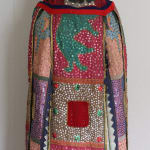 Egungun masquerade costume
Egungun masquerade costume
 Egungun masquerade costume
Egungun masquerade costume
 Egungun masquerade costume
Egungun masquerade costume
 Egungun masquerade costume
Egungun masquerade costume
 Egungun masquerade costume
Egungun masquerade costume
 Egungun masquerade costume
Egungun masquerade costume
 Egungun masquerade costume
Egungun masquerade costume
 Egungun masquerade costume
Egungun masquerade costume
 Egungun masquerade costume
Egungun masquerade costume
Anonymous Yoruba artist (Republic of Benin)
Anonymous Yoruba artist (Republic of Benin)
height 69 in
Further images
-
(View a larger image of thumbnail 1
)

-
(View a larger image of thumbnail 2
)

-
(View a larger image of thumbnail 3
)

-
(View a larger image of thumbnail 4
)

-
(View a larger image of thumbnail 5
)

-
(View a larger image of thumbnail 6
)

-
(View a larger image of thumbnail 7
)

-
(View a larger image of thumbnail 8
)

-
(View a larger image of thumbnail 9
)

This vibrantly colored costume once was danced during Egungun festivals of the Yoruba people in eastern Benin. Egungun is a visible manifestation of the spirits of ancestors who periodically revisit the human community for remembrance, celebration, and blessings. “Egungun” means “supernatural power concealed”; a power and presence that can be invoked by the living. The cloth ties the spirit of Egungun to the world of the living by creating in essence “a cage of fabric”.
Egungun masquerades honor ancestors and at the same time serve as important status symbols for the living. A continuous and reciprocal relationship units those from beyond and those in the world. An individual exists because he/she is part of a larger entity or lineage (idile). This idile includes all persons, whether deceased or living, who trace their origins to a common progenitor. Membership in an idile anchors an individual in time and space. It gives the person a deep sense of belonging, of purpose – a concept of self that is seen in terms of an unbroken chain of existence. Egungun magnifies the importance of both its owner and his lineage.
Egungun masqueraders perform at funerals or other special family occasions, as well as at annual or biennial festivals. During these celebrations costumed men move through the town embodying the presence of their ancestors while singing praise and being offered invocations. Though women and children participate by singing, dancing, and watching, they are kept at a safe distance from the masqueraders, whose actions are unpredictable. The appearance of Egungun in a community is accompanied by pomp and pageantry, drumming and dancing, singing and celebration. These celebrations commemorate the ancestors who founded the lineage and continue to affect the daily existence of the living. Through rituals lasting several weeks, the masqueraders may visit lineage compounds to bless or punish their descendants. These spirits constantly bless, protect, warn, and punish their earthly descendants depending on how their relatives neglect or honor them. The festival strengthens the bonds that unite families and communities with departed ancestors.
Egungun masquerade costumes are commissioned and owned by men. The making of a costume involves close consultation with a tailor and sometimes a sculptor if a wooden headdress is required. It also necessitates the assistance of a diviner, who can communicate with the spirit world; an herbalist, who makes packets of protective medicines that are attached to the costume; and the leader of the Egungun society. The latter performs rituals to sanctify the costume and selects the young man who will wear it while performing. Owning and wearing a masquerade costume is demanding, but it also brings personal prestige and demonstrates a man’s commitment to his extended family, which is held in great esteem.
The costumes were constructed of disparate fabrics, both locally woven and industrially manufactured, in addition to sequins, beads, leather, and potent empowering materials. The chosen fabrics were literally the best that money could buy, and included damask, velvet, silk, Indian madras, and printed cotton. The wealth and status of the family, as well as the power of the ancestors were celebrated with this spectacular assemblage of materials. The valuable fabrics and symbols of wealth such as cowrie shells, sequins, and beads were outward signs of the respect due to the ancestor. The tailor who fashioned this costume appliquéd its panels with motifs drawn from Yoruba, Islamic, and European traditions.
The body of the dancer was completely covered by layer upon layer of cloth. The wearer could see through a net face panel, which often was adorned with cowrie shells and beads. Egungun masquerade performances were augmented by intricate body movements and carefully orchestrated dance steps of the dancer. He would spin rapidly so the fabric panels flew out, swirling the fabrics and colors, thus revealing the many colorful layers of the costume. While dancing, the costume unveils the spirit. Indeed, Egungun performances were a manifestation of a spirit in motion. The movement of these cloths generates what researchers have termed a ‘breeze of blessing’ through the crowd. Even without a dancer, these costumes inspire and breathe divines.
This specific type of Egungun masquerades can be traced to the Yoruba lineages in Ouidah in the Abomey region of the Republic of Benin. This tradition has become a major symbol of Yoruba identity in southern Benin, which is mostly populated by Fon people.
Provenance
Acquired from Aboudou Inowa "El Hadj Inoa", Cotonou, 2003
van Rijn family Collection, Brussels
let's keep in touch
Join our community & never miss out on a DUENDE moment from now on
* denotes required fields
We will process the personal data you have supplied to communicate with you in accordance with our Privacy Policy. You can unsubscribe or change your preferences at any time by clicking the link in our emails.